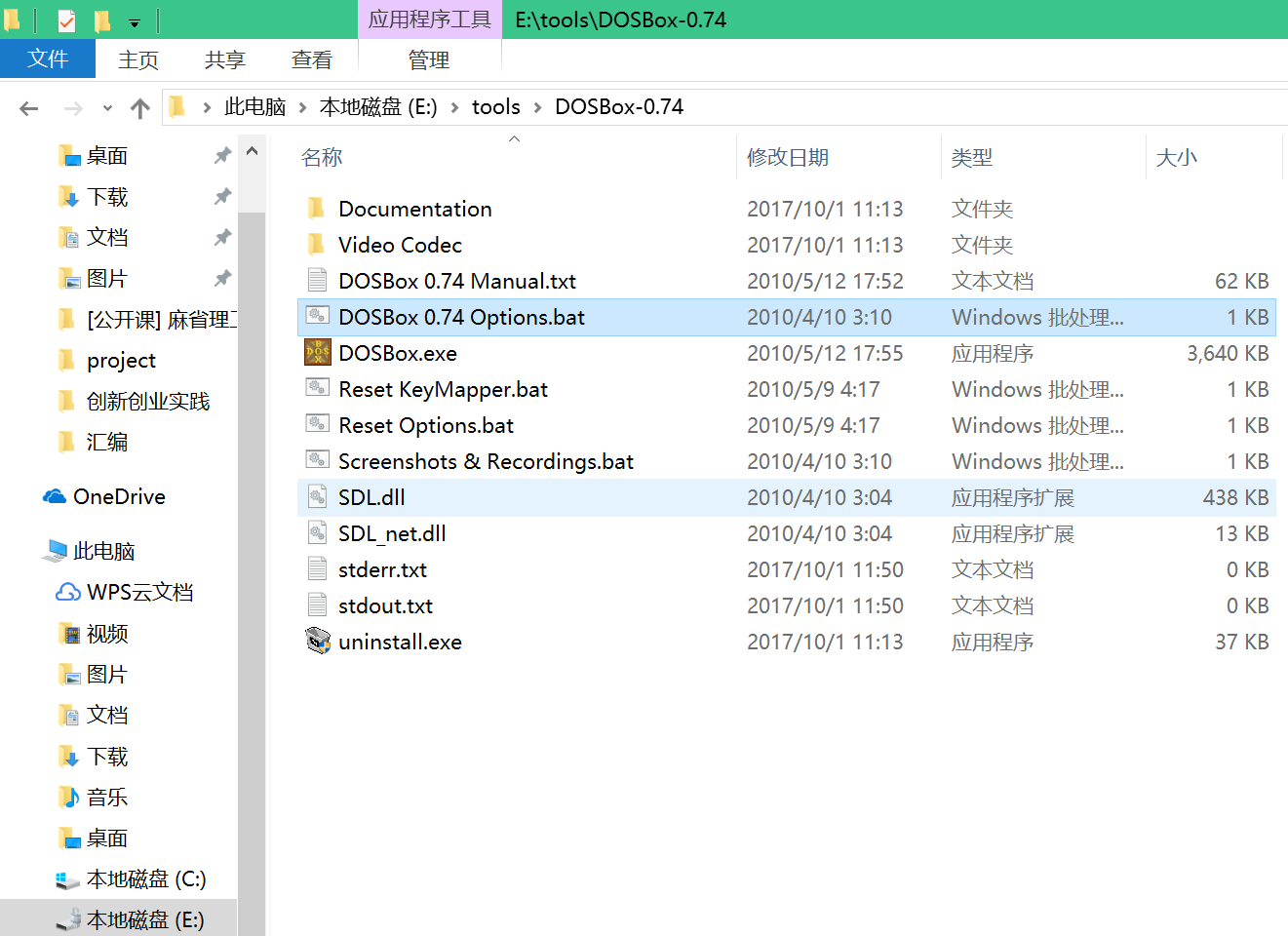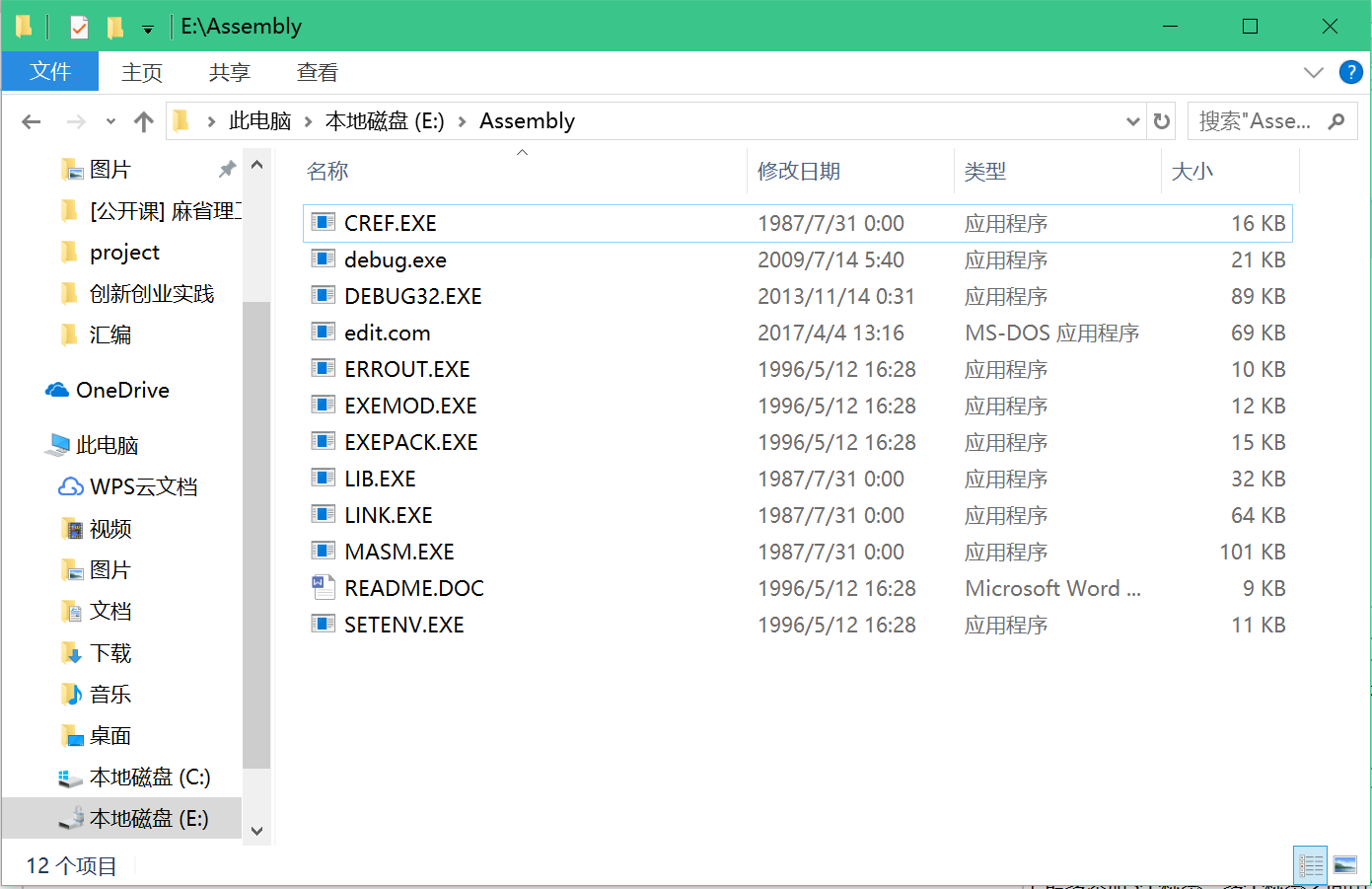masm、dosbox的获取、安装请参考这位博主的文章:
点击打开链接http://blog.csdn.net/doniexun/article/details/45438457
但是这位博主提供的办法每次都需要映射一次虚拟C盘(略微有些麻烦)
所以这里参考了百度文库中的一篇文章:
点击打开链接https://wenku.baidu.com/view/395f10e4b9d528ea81c77970.html
这里我重新描述一下,先安装好dosbox之后,在安装的文件夹中
就是这一个
用记事本打开之后,拖到底部
本来是没有mount C E:Assembly的,这句话是说明将E盘根目录下的一个文件夹作为虚拟C盘(具体文件夹视个人选择而定)
不过这个文件夹里要求是按照那位博主所说的装入那些配置文件的文件夹
好了,还剩最后一步,打开dosbox是不是有一个窗口特别小(那个就是编程的界面……)
方法是在贴吧找到的:
点击打开链接https://tieba.baidu.com/p/2150370425?red_tag=1659853681
还是找到
将楼主的代码把文件中的替换就好
大体位置在箭头所指位置,另外圈出的那组数字表示的是窗口大小(根据自己的要求更改,注意是x不是*)
这是我的那个文件内的所有内容,可以全部替换之后,改一下虚拟C盘的地址就行
# This is the configurationfile for DOSBox 0.74. (Please use the latest version of DOSBox)
# Lines starting with a # are commentlines and are ignored by DOSBox.
# They are used to (briefly) document the effect of each option.
[sdl]
#
fullscreen: Start dosbox directly in fullscreen. (Press ALT-Enter to go back)
#
fulldouble: Use double buffering in fullscreen. It can reduce screen flickering, but it can also result in a slow DOSBox.
#
fullresolution: What resolution to use for fullscreen: original or fixed size (e.g. 1024x768).
#
Using your monitor's native resolution with aspect=true might give the best results.
#
If you end up with small window on a large screen, try an output different from surface.
# windowresolution: Scale the window to this size IF the output device supports hardware scaling.
#
(output=surface does not!)
#
output: What video system to use for output.
#
Possible values: surface, overlay, opengl, openglnb, ddraw.
#
autolock: Mouse will automatically lock, if you click on the screen. (Press CTRL-F10 to unlock)
#
sensitivity: Mouse sensitivity.
#
waitonerror: Wait before closing the console if dosbox has an error.
#
priority: Priority levels for dosbox. Second entry behind the comma is for when dosbox is not focused/minimized.
#
pause is only valid for the second entry.
#
Possible values: lowest, lower, normal, higher, highest, pause.
#
mapperfile: File used to load/save the key/event mappings from. Resetmapper only works with the defaul value.
#
usescancodes: Avoid usage of symkeys, might not work on all operating systems.
fullscreen=false
fulldouble=false
fullresolution=original
windowresolution=1420x980
output=opengl
autolock=true
sensitivity=100
waitοnerrοr=true
priority=higher,normal
mapperfile=mapper-0.74.map
usescancodes=true
[render]
frameskip=0
aspect=false
scaler=normal2x
[dosbox]
# language: Select another language file.
#
machine: The type of machine tries to emulate.
#
Possible values: hercules, cga, tandy, pcjr, ega, vgaonly, svga_s3, svga_et3000, svga_et4000, svga_paradise, vesa_nolfb, vesa_oldvbe.
# captures: Directory where things like wave, midi, screenshot get captured.
#
memsize: Amount of memory DOSBox has in megabytes.
#
This value is best left at its default to avoid problems with some games,
#
though few games might require a higher value.
#
There is generally no speed advantage when raising this value.
language=
machine=svga_s3
captures=capture
memsize=16
[render]
# frameskip: How many frames DOSBox skips before drawing one.
#
aspect: Do aspect correction, if your output method doesn't support scaling this can slow things down!.
#
scaler: Scaler used to enlarge/enhance low resolution modes.
#
If 'forced' is appended, then the scaler will be used even if the result might not be desired.
#
Possible values: none, normal2x, normal3x, advmame2x, advmame3x, advinterp2x, advinterp3x, hq2x, hq3x, 2xsai, super2xsai, supereagle, tv2x, tv3x, rgb2x, rgb3x, scan2x, scan3x.
frameskip=0
aspect=false
scaler=normal2x
[cpu]
#
core: CPU Core used in emulation. auto will switch to dynamic if available and appropriate.
#
Possible values: auto, dynamic, normal, simple.
#
cputype: CPU Type used in emulation. auto is the fastest choice.
#
Possible values: auto, 386, 386_slow, 486_slow, pentium_slow, 386_prefetch.
#
cycles: Amount of instructions DOSBox tries to emulate each millisecond.
#
Setting this value too high results in sound dropouts and lags.
#
Cycles can be set in 3 ways:
#
'auto'
tries to guess what a game needs.
#
It usually works, but can fail for certain games.
#
'fixed #number' will set a fixed amount of cycles. This is what you usually need if 'auto' fails.
#
(Example: fixed 4000).
#
'max'
will allocate as much cycles as your computer is able to handle.
#
#
Possible values: auto, fixed, max.
#
cycleup: Amount of cycles to decrease/increase with keycombo.(CTRL-F11/CTRL-F12)
# cycledown: Setting it lower than 100 will be a percentage.
core=auto
cputype=auto
cycles=auto
cycleup=10
cycledown=20
[mixer]
#
nosound: Enable silent mode, sound is still emulated though.
#
rate: Mixer sample rate, setting any device's rate higher than this will probably lower their sound quality.
#
Possible values: 44100, 48000, 32000, 22050, 16000, 11025, 8000, 49716.
# blocksize: Mixer block size, larger blocks might help sound stuttering but sound will also be more lagged.
#
Possible values: 1024, 2048, 4096, 8192, 512, 256.
# prebuffer: How many milliseconds of data to keep on top of the blocksize.
nosound=false
rate=44100
blocksize=1024
prebuffer=20
[midi]
#
mpu401: Type of MPU-401 to emulate.
#
Possible values: intelligent, uart, none.
# mididevice: Device that will receive the MIDI data from MPU-401.
#
Possible values: default, win32, alsa, oss, coreaudio, coremidi, none.
# midiconfig: Special configuration options for the device driver. This is usually the id of the device you want to use.
#
See the README/Manual for more details.
mpu401=intelligent
mididevice=default
midiconfig=
[sblaster]
#
sbtype: Type of Soundblaster to emulate. gb is Gameblaster.
#
Possible values: sb1, sb2, sbpro1, sbpro2, sb16, gb, none.
#
sbbase: The IO address of the soundblaster.
#
Possible values: 220, 240, 260, 280, 2a0, 2c0, 2e0, 300.
#
irq: The IRQ number of the soundblaster.
#
Possible values: 7, 5, 3, 9, 10, 11, 12.
#
dma: The DMA number of the soundblaster.
#
Possible values: 1, 5, 0, 3, 6, 7.
#
hdma: The High DMA number of the soundblaster.
#
Possible values: 1, 5, 0, 3, 6, 7.
# sbmixer: Allow the soundblaster mixer to modify the DOSBox mixer.
# oplmode: Type of OPL emulation. On 'auto' the mode is determined by sblaster type. All OPL modes are Adlib-compatible, except for 'cms'.
#
Possible values: auto, cms, opl2, dualopl2, opl3, none.
#
oplemu: Provider for the OPL emulation. compat might provide better quality (see oplrate as well).
#
Possible values: default, compat, fast.
# oplrate: Sample rate of OPL music emulation. Use 49716 for highest quality (set the mixer rate accordingly).
#
Possible values: 44100, 49716, 48000, 32000, 22050, 16000, 11025, 8000.
sbtype=sb16
sbbase=220
irq=7
dma=1
hdma=5
sbmixer=true
oplmode=auto
oplemu=default
oplrate=44100
[gus]
#
gus: Enable the Gravis Ultrasound emulation.
#
gusrate: Sample rate of Ultrasound emulation.
#
Possible values: 44100, 48000, 32000, 22050, 16000, 11025, 8000, 49716.
#
gusbase: The IO base address of the Gravis Ultrasound.
#
Possible values: 240, 220, 260, 280, 2a0, 2c0, 2e0, 300.
#
gusirq: The IRQ number of the Gravis Ultrasound.
#
Possible values: 5, 3, 7, 9, 10, 11, 12.
#
gusdma: The DMA channel of the Gravis Ultrasound.
#
Possible values: 3, 0, 1, 5, 6, 7.
# ultradir: Path to Ultrasound directory. In this directory
#
there should be a MIDI directory that contains
#
the patch files for GUS playback. Patch sets used
#
with Timidity should work fine.
gus=false
gusrate=44100
gusbase=240
gusirq=5
gusdma=3
ultradir=C:ULTRASND
[speaker]
# pcspeaker: Enable PC-Speaker emulation.
#
pcrate: Sample rate of the PC-Speaker sound generation.
#
Possible values: 44100, 48000, 32000, 22050, 16000, 11025, 8000, 49716.
#
tandy: Enable Tandy Sound System emulation. For 'auto', emulation is present only if machine is set to 'tandy'.
#
Possible values: auto, on, off.
# tandyrate: Sample rate of the Tandy 3-Voice generation.
#
Possible values: 44100, 48000, 32000, 22050, 16000, 11025, 8000, 49716.
#
disney: Enable Disney Sound Source emulation. (Covox Voice Master and Speech Thing compatible).
pcspeaker=true
pcrate=44100
tandy=auto
tandyrate=44100
disney=true
[joystick]
# joysticktype: Type of joystick to emulate: auto (default), none,
#
2axis (supports two joysticks),
#
4axis (supports one joystick, first joystick used),
#
4axis_2 (supports one joystick, second joystick used),
#
fcs (Thrustmaster), ch (CH Flightstick).
#
none disables joystick emulation.
#
auto chooses emulation depending on real joystick(s).
#
(Remember to reset dosbox's mapperfile if you saved it earlier)
#
Possible values: auto, 2axis, 4axis, 4axis_2, fcs, ch, none.
#
timed: enable timed intervals for axis. Experiment with this option, if your joystick drifts (away).
#
autofire: continuously fires as long as you keep the button pressed.
#
swap34: swap the 3rd and the 4th axis. can be useful for certain joysticks.
#
buttonwrap: enable button wrapping at the number of emulated buttons.
joysticktype=auto
timed=true
autofire=false
swap34=false
buttonwrap=false
[serial]
# serial1: set type of device connected to com port.
#
Can be disabled, dummy, modem, nullmodem, directserial.
#
Additional parameters must be in the same line in the form of
#
parameter:value. Parameter for all types is irq (optional).
#
for directserial: realport (required), rxdelay (optional).
#
(realport:COM1 realport:ttyS0).
#
for modem: listenport (optional).
#
for nullmodem: server, rxdelay, txdelay, telnet, usedtr,
#
transparent, port, inhsocket (all optional).
#
Example: serial1=modem listenport:5000
#
Possible values: dummy, disabled, modem, nullmodem, directserial.
# serial2: see serial1
#
Possible values: dummy, disabled, modem, nullmodem, directserial.
# serial3: see serial1
#
Possible values: dummy, disabled, modem, nullmodem, directserial.
# serial4: see serial1
#
Possible values: dummy, disabled, modem, nullmodem, directserial.
serial1=dummy
serial2=dummy
serial3=disabled
serial4=disabled
[dos]
#
xms: Enable XMS support.
#
ems: Enable EMS support.
#
umb: Enable UMB support.
# keyboardlayout: Language code of the keyboard layout (or none).
xms=true
ems=true
umb=true
keyboardlayout=auto
[ipx]
# ipx: Enable ipx over UDP/IP emulation.
ipx=false
[autoexec]
# Lines in this section will be run at startup.
# You can put your MOUNT lines here.
mount C E:Assembly最后
以上就是唠叨小伙最近收集整理的关于win10-64位-汇编环境配置的全部内容,更多相关win10-64位-汇编环境配置内容请搜索靠谱客的其他文章。
本图文内容来源于网友提供,作为学习参考使用,或来自网络收集整理,版权属于原作者所有。













发表评论 取消回复